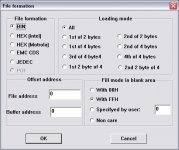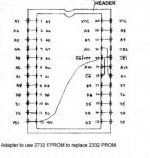giobbi
Veteran Member
Dave,
thank you for you interest (well, thanks all you people for the great support!)
Unfortunately I'm totally profane about low-level programming and hardware, so what you told it isn't totally obvious for me (what a shame!)
Well, I need you tell me what to do next. I can't wait for your diagnostic!
thank you again!
-- Giovi
-----------------------EDIT :::: IMPORTANT CLUE (at least, I believe it's important!).
I looked at the part lists from Zimmers and I see there are two alternative ROMs for the edit ROM in UD8: 901447-24 (E000-E7EE) and 901474-01 (E000-E7FF ? <- marked by hand on the schematics). So I programmed a 2716 with the 901474-01 and I tested it.
WITH THIS .BIN THE COMPUTER IS WORKING! BUT:
- the keyboard has an incorrect layout (maybe it's the .bin image for the business keyboard...?)
- Sometimes it shows just 15359 bytes free and sometimes 31743 bytes free.
I've tried to program a 2716 with the other image (901447-24 but this way it stucks: garbage -> black).
Getting closer!
thank you for you interest (well, thanks all you people for the great support!)
Unfortunately I'm totally profane about low-level programming and hardware, so what you told it isn't totally obvious for me (what a shame!)
Well, I need you tell me what to do next. I can't wait for your diagnostic!
thank you again!
-- Giovi
-----------------------EDIT :::: IMPORTANT CLUE (at least, I believe it's important!).
I looked at the part lists from Zimmers and I see there are two alternative ROMs for the edit ROM in UD8: 901447-24 (E000-E7EE) and 901474-01 (E000-E7FF ? <- marked by hand on the schematics). So I programmed a 2716 with the 901474-01 and I tested it.
WITH THIS .BIN THE COMPUTER IS WORKING! BUT:
- the keyboard has an incorrect layout (maybe it's the .bin image for the business keyboard...?)
- Sometimes it shows just 15359 bytes free and sometimes 31743 bytes free.
I've tried to program a 2716 with the other image (901447-24 but this way it stucks: garbage -> black).
Getting closer!
Last edited:


